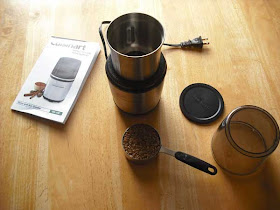Two different 70:30 Rye breads
These are 70:30 rye:ww breads. They were bulk fermented for 8 hours overnight with no salt.
In the morning, I added the salt and a bit more water, bringing it to about 80% hydration. After an hour, I divided the dough and put it into tins. They then sat 4 hours until baked.
There are 2 loaves of each kind of dough, both are 70:30 rye:ww flours. But one of them was 1/2 chops. I used my new spice grinder to grind up 350g of rye kernels, and 150g of wheat berries (half of the flour, for one of the doughs). I thought I ground them to the flour stage, but there were still some small chunks in the flour.
The kernels can be ground up 1/4 cup at a time.
- 1/4 cup of wheat kernels makes about 50g of chops.
- 1/4 cup of rye chops makes about 32g of chops.
Results
I was hoping with this baking to see if I could duplicate the excellent results I had with a longer fermentation time of a rye bread. I just wanted to see if I could move the lengthening time of fermentation to the earlier bulk fermentation end, instead of the later proofing stage. I don't think the results were quite as good as the last time.
In this experiment I was also trying to see the effect of adding chops to a loaf (vs not adding chops). You can see that the volume of the one with chops is somewhat less. I found the loaf with chops staled a bit quicker too. I think that when fresh, it had the superior (nuttier) taste.
Unfortunately, I burned the roof of my mouth on a baked potato the same day I made these, and I found these breads extremely hard to eat because of it. I couldn't taste much. These are hard, quickly staling breads. Both the burn in my mouth and the bread took about a week to get over.
Notes to Myself
- I could not for the life of me understand why these breads staled far quicker than the last rye bread I made. As I cast about for a reason, I picked up Daniel Wing and Alan Scott's book "The Bread Builders: Hearth Loaves and Masonry Ovens" once again, and read there the section on Stale Bread (p. 105 etc.). This is an excellent discussion, more complete than I have ever seen anywhere else, collecting science from lots of studies that have sampled hydration of crumb and crust over time, and analysis of the structure of the crumb. But while it suggests some reasons why my loaf staled quickly, it also hinted that because of its sourdough leaven and its wholegrain goodness, it shouldn't have staled so fast.
Suggestions gleaned from the discussion as to why it may have staled so fast: - it was over-fermented
- it was baked too hot or too long



















































